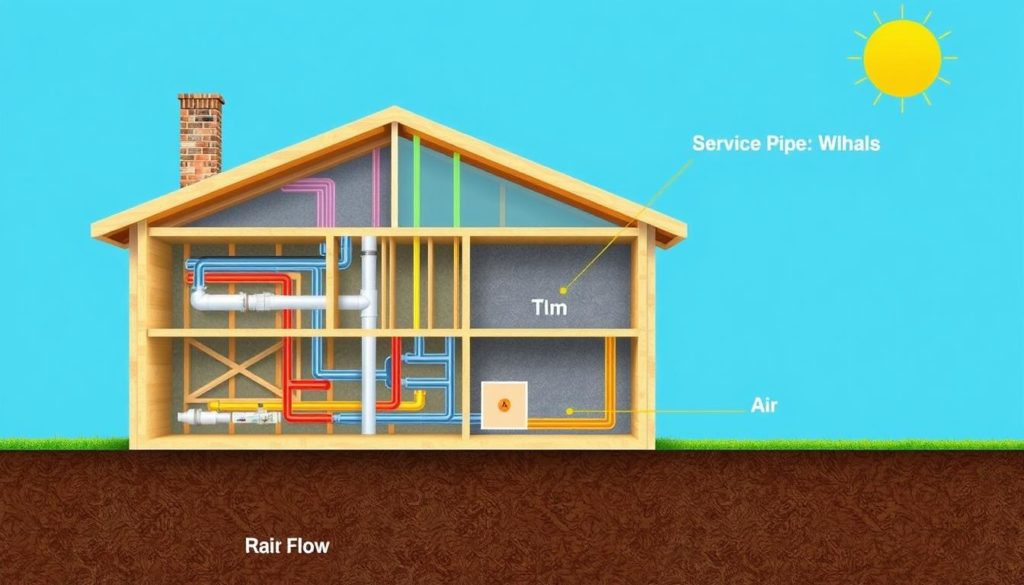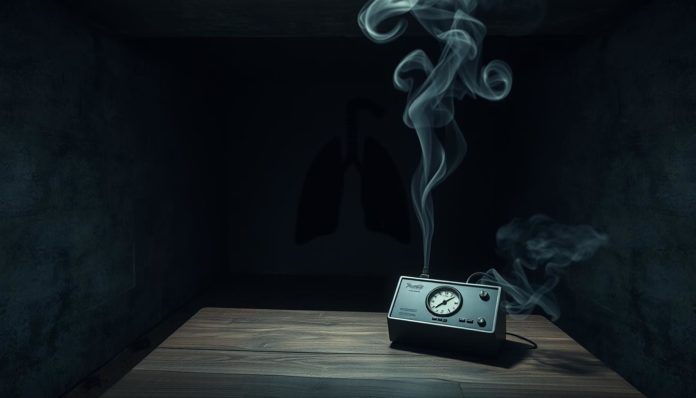Did you know radon is a major cause of lung cancer, second only to smoking? This fact comes straight from the American Cancer Society. Radon, a harmful gas, is colorless and odorless. It comes from uranium breaking down in the soil. Since you can’t see or smell it, many don’t know it’s there. That’s why testing for radon is key to preventing lung cancer.
The EPA has guidelines for radon in homes. They say any level over 4 pCi/L needs fixing to cut health risks. By understanding radon’s risks, you can keep your home safe. It’s important to know about this and act to protect your family.
Understanding Radon Gas
Radon gas comes from uranium breaking down in almost all soils. It moves up through the ground. It can get into buildings through cracks in foundations and walls.
The amount of radon inside can change due to the soil, geology, how the building is made, and the weather. When radon breaks down, it releases harmful particles. Breathing these in can hurt lung tissue and raise the risk of lung cancer over time.

The United States Geological Survey (USGS) has maps that show radon potential. These are based on geological surveys. These maps help people know when to test for radon.
| Factor | Impact on Radon Levels |
|---|---|
| Soil Composition | Varies radon gas production rates |
| Local Geology | Influences natural uranium deposits |
| Building Construction | Affects entry points for radon |
| Weather Conditions | Can alter radon gas movement |
Knowing what factors lead to radon and testing your home often are key. They help make your living space safer.
How Radon Gas Enters Your Home
Radon gas can get into your home in several ways. Knowing where it comes from is key. It helps improve the air quality inside.
Cracks in Foundations
Cracks in the foundation are a common entry for radon. Natural settling or weaknesses can create these cracks. Through them, radon from the soil can enter, affecting the air you breathe.
Construction Joints
Construction joints are another weak spot. They are where different building materials meet, like where walls and floors come together. Radon can slip through any gaps here, raising its levels indoors.
Service Pipes & Wall Cavities

Pipes and wall cavities can also let radon in. Fixtures for electrical and plumbing work make small holes. These holes can suck in radon because of the lower pressure inside buildings. Sealing these spots and adding a radon system helps clean your air.
| Entry Point | Effect on Indoor Air Quality | Solution |
|---|---|---|
| Cracks in Foundation | High radon levels | Seal cracks, install mitigation system |
| Construction Joints | Medium radon levels | Proper sealing, regular inspections |
| Service Pipes & Wall Cavities | Variable radon levels | Professional sealing, use of radon barriers |
The Science Behind Radon and Lung Cancer
There’s a lot of research about *Radon and Lung Cancer Risk*. Breathing in radon decay products can really harm lung tissue. Radon exposure leads to radioactive particles getting stuck in the lungs. This can cause cellular damage and mutations over time. These mutations may turn into cancer, increasing lung cancer risk.
How Radon Affects Lung Tissue
Understanding radon’s impact on lung tissue involves knowing about radioactive decay. Radon breaks down into alpha particles. These particles can break through lung cell walls. This breakage harms DNA, which can cause mutations. These mutations might cause cells to grow uncontrollably, leading to cancer. This damage accumulates slowly and can lead to serious problems.
Long-term Exposure and Cancer Risk
Many studies, like those from the National Cancer Institute, confirm the dangers of long-term radon exposure. Being exposed to high radon levels for a long time increases lung cancer risk. This risk is even bigger for people in poorly ventilated areas who experience this exposure for years. Both the EPA and WHO label radon as a cancer-causing agent. The chance of getting lung cancer changes based on how long and how much radon you’re exposed to.
| Factors Influencing Risk | Description |
|---|---|
| Duration of Exposure | Long-term radon exposure increases the risk significantly, especially when measured in years. |
| Concentration of Radon | Higher radon levels lead to a greater number of radioactive particles trapped in lung tissue. |
| Smoking | Smokers are at a higher risk as the combined effects of smoking and radon exposure magnify the damage to lung tissues. |
Lung Cancer Awareness and Radon Exposure
Raising lung cancer awareness is very important, especially the risks from radon exposure. The American Cancer Society and other groups work hard to teach people about radon dangers.
Lung Cancer Awareness Month is a great time to talk about the dangers of radon. It also stresses the need for regular radon checks and fixing problems. Many people still don’t know about radon, so teaching them is crucial.
“Radon is a silent but significant risk factor for lung cancer. Increased education and advocacy for regular radon testing are key to early detection and intervention, ultimately saving countless lives,” asserts leading public health experts.
Pushing for regular radon tests can help find and solve problems early. This can stop many lung cancers. Making sure everyone knows about the dangers of radon is key.
| Action | Purpose |
|---|---|
| Public Awareness Campaigns | Educate about radon exposure risks and encourage radon testing. |
| Promotion during Lung Cancer Awareness Month | Highlight the importance of radon as a risk factor for lung cancer. |
| Encouraging Regular Radon Testing | Early detection of radon levels to implement timely mitigation strategies. |
More awareness and actions against radon can lead to better health and save lives.
Radon Testing: Why, When, and How
Radon testing checks if a place has high radon levels. Since we can’t see or smell radon, testing is the only way to find it. There are many radon tests for both short and long periods.
Types of Radon Tests
Radon testing kits come in two main types:
- Short-term tests: These kits test radon levels from 2 to 7 days. They’re good for a first quick check.
- Long-term tests: These kits measure radon over up to 90 days. They give a more accurate average level.
- Continuous radon monitors: These devices keep checking radon levels all the time. They’re great for always keeping an eye on radon.
Interpreting Radon Test Results
Understanding your radon test results is important. Results are given in picocuries per liter (pCi/L). The EPA says if levels are 4 pCi/L or higher, you need to act. High radon levels mean you should lower them to keep people safe.
Knowing how to read test results helps you make the right moves to lower radon. This makes your indoor air healthier.
It’s vital to test for radon regularly. This keeps radon levels safe where you live or work.
Steps for Radon Mitigation
Making your home safe from radon is vital for good health. Here are the main steps to take:
- Identify High Radon Levels: Test your home to see if radon levels are too high. If they are, act fast to fix it.
- Engage Professional Mitigators: Hire experts in radon. They know how to set up systems to keep radon out of your house.
- Seal Cracks and Openings: Seal any cracks and openings in your home’s base. This helps stop more radon from coming in.
- Enhance Ventilation: Better air flow, especially in basements, can lower radon levels. It also makes the air in your house cleaner.
- Post-Mitigation Testing: After the system is in, test the radon levels again. Make sure they have dropped. Keep checking to stay safe.
Lowering radon in your home cuts cancer risk and improves air inside. Following these steps will make where you live safer and more cozy. Always watch and keep up your system to be sure your home stays radon-free.
Indoor Air Quality and Radon Levels
Making sure our indoor air is clean is crucial for health. Radon, a dangerous gas, can sneak into our homes, harming air quality. To keep air safe, it’s important to control radon levels. Here are tips on how to keep track and improve air quality.
Improving Indoor Air Quality
To better indoor air and lower radon, think about using ventilation systems. Heat recovery ventilators (HRV) and energy recovery ventilators (ERV) work well. They swap inside air with outside air, lowering radon and other pollutants.
Keeping our indoor air clean means airing out spaces often to cut down on pollutants.
Monitoring Radon Levels Over Time
It’s important to regularly check radon levels because they can change. This can be due to the weather, seasons, or changes in your home. Smart home systems now offer advanced devices for detecting radon. These gadgets monitor radon in real time and send alerts if levels go up.
By keeping an eye on radon, we protect our air quality and health. This shields us and our loved ones from radon’s dangers.
Radon in Homes and the Need for Regular Testing
Radon exposure can lead to lung cancer, so it’s vital for homeowners to test regularly. It doesn’t matter where you live or how your home is built. Radon can be a danger to anyone. By testing for radon often, you can catch it early and prevent lung cancer, keeping your home safe.
In buying or selling houses, radon testing is becoming more key. Awareness about radon in homes is growing. People buying or selling homes now often check radon levels. This makes sure homes are safe and has become a regular step in inspecting homes.
Homes with once low radon might not always stay safe. Things like new construction or changes in the soil can raise radon levels. That’s why health experts suggest testing every two years or with any big home changes. This helps keep lung cancer prevention efforts up.
Making radon testing a common practice is a smart move for homeowners. It allows you to act if radon levels are high, keeping your home safe. As more people test for radon, we can lower the risk of exposure. Together, we can fight against radon-linked lung cancer.
FAQ
What is radon, and how does it relate to lung cancer risk?
Radon is a colorless and odorless radioactive gas. It comes from the natural decay of uranium in the soil. It’s the second leading cause of lung cancer, after smoking. The American Cancer Society highlights the link between radon exposure and lung cancer risk. It’s crucial to understand this to prevent lung cancer.
How does radon gas enter homes?
Radon can enter homes through cracks in foundations, and gaps around pipes. Buildings under negative pressure can also pull in radon, affecting air quality.
What are the health risks associated with radon exposure?
Long-term radon exposure can raise lung cancer risk, especially for smokers. Breathing in radon decay products can damage lung tissue and lead to cellular mutations.
Why is radon testing important?
Testing your home for radon levels is vital. Since radon is undetectable by senses, testing is the only way to know about radon concentrations. This helps address potential health risks.
What types of radon tests are available?
You can use short-term or long-term radon tests, or continuous radon monitors. Short-term tests help with initial screening. Long-term tests give a better average radon level over time.
How can radon levels be reduced in a home?
If tests show high radon levels, professionals can install mitigation systems to lower them. Sealing cracks and improving ventilation also helps reduce radon levels. This improves the air quality indoors.
Is regular radon testing necessary even if previous tests showed low levels?
Regular radon testing is recommended. This is because radon levels can change with home renovations or changes in the soil. Testing every two years, or after home changes, is suggested by public health initiatives.
How does radon mitigation impact indoor air quality?
Radon mitigation lowers radon levels, which helps improve indoor air quality. Safe radon levels make homes healthier and safer.
What role does public awareness play in radon testing and lung cancer prevention?
Raising public awareness about radon can help prevent lung cancer. Events like Lung Cancer Awareness Month highlight radon’s risks. They also emphasize the importance of testing and mitigating radon. This can save lives through informed actions.
Where can I find more information or resources about radon and lung cancer risk?
For reliable radon info, check out the EPA, the American Cancer Society, and the USGS. These organizations offer guidance on testing and mitigating radon. They aim to improve indoor air quality and reduce radon exposure risks.


